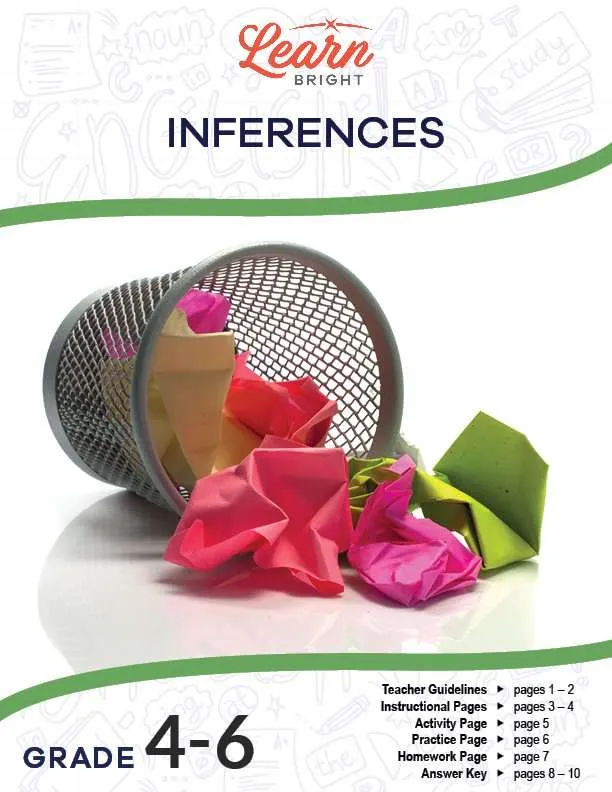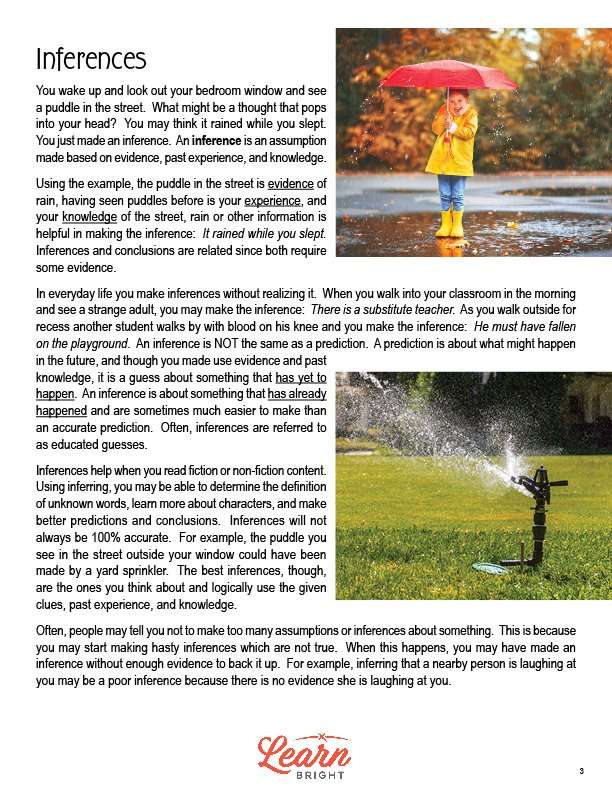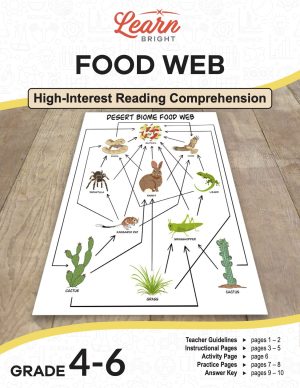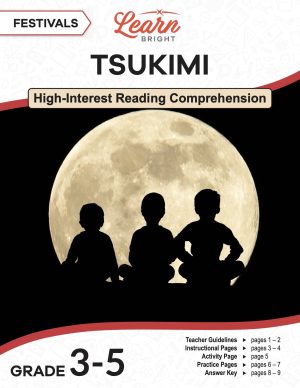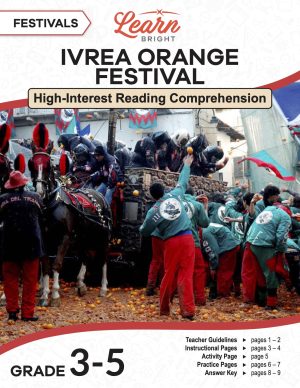Description
What our Inferences lesson plan includes
Lesson Objectives and Overview: Inferences develops critical thinking skills as students learn to define what an inference is and use context clues from text to make inferences. This lesson is for students in 4th grade, 5th grade, and 6th grade.
Classroom Procedure
Every lesson plan provides you with a classroom procedure page that outlines a step-by-step guide to follow. You do not have to follow the guide exactly. The guide helps you organize the lesson and details when to hand out worksheets. It also lists information in the green box that you might find useful. You will find the lesson objectives, state standards, and number of class sessions the lesson should take to complete in this area. In addition, it describes the supplies you will need as well as what and how you need to prepare beforehand. For this lesson, the only supplies you will need are the handouts. To prepare for this lesson ahead of time, you can set up an example for the lesson opening, pair students for the activity, and copy the handouts.
Options for Lesson
Included with this lesson is an “Options for Lesson” section that lists a number of suggestions for activities to add to the lesson or substitutions for the ones already in the lesson. An optional extension of the activity worksheet is to add additional pictures for students to make inferences about. You can have students make inferences about the characters, events, and more in their current reading material. You can also distribute higher level reading material that contains vocabulary that your students don’t know and have them make inferences about the definitions of the unknown words. Finally, you can take your students for a walk through your school and point out things for them to make inferences about (like a spill or an out-of-place lunchbox).
Teacher Notes
The teacher notes page includes a paragraph with additional guidelines and things to think about as you begin to plan your lesson. It notes that it will be important for you to emphasize the difference between a prediction and an inference while teaching this lesson. This page also includes space that you can use to add your own notes as you’re preparing for this lesson.
INFERENCES LESSON PLAN CONTENT PAGES
Inferences
The Inferences lesson plan includes two pages of content. The lesson begins by asking students what their first thought might be if they looked outside and saw a puddle in the street. Thinking, for example, that it must have rained overnight, is an example of an inference. Inferences are assumptions made based on evidence, past experience, and knowledge. The puddle in the street, for example, is evidence of rain, while having seen puddles before is your experience. Your knowledge of the street, how rain and water behave, and other information is also valuable in making the inference that it rained while you were asleep. Students will learn that inferences and conclusions, while not exactly the same, are related. They’re both based on evidence!
You make inferences every single day, likely without even noticing! If you arrive at school and see that a strange adult is sitting at your teacher’s desk, you infer that they’re a substitute teacher. If you see another student with a bloody knee coming in from recess, you can infer that they fell and scraped their knee. It is important to note that inferences are not predictions. Predictions, though they are also based on evidence, are what you think will happen at some point in the future — something that has yet to happen. Inferences are about things that have already happened. We sometimes call inferences educated guesses, as they are guesses about something based on evidence, experience, and knowledge.
Inferences can be useful in your day-to-day life and when reading both fiction or nonfiction texts. You can use inferring to determine the meaning of unfamiliar words, figure something out about a character, or make a good prediction about what will happen next. However, it is important to remember that your inferences will not always be correct. Going back to the original example, the puddle you see in the street could have been caused by a sprinkler instead of rain. You can make better, more accurate inferences by thinking through the clues, your past experience, and your knowledge logically.
Some people might tell you not to make too many inferences, or assumptions. If you make an inference too quickly or without enough evidence, you may make an incorrect assumption about something or someone in your life. When reading, incorrect inferences can lead to you potentially misunderstanding the plot, characters, or events.
The lesson then shows students how they could infer the meaning of a made-up word, goodags, using an example sentence. It breaks the process down into four sections: the initial questions (“What are goodags?” and “What does the word mean?”), the evidence, the prior knowledge, and, finally, the inference. This illustrates that you can make logical and accurate inferences if you break the process down into these steps. Identify the question, seek the necessary evidence, and use your prior knowledge. Reading more will also help you become better at inferring (and will expand your vocabulary)!
INFERENCES LESSON PLAN WORKSHEETS
The Inferences lesson plan includes three worksheets: an activity worksheet, a practice worksheet, and a homework assignment. You can refer to the guide on the classroom procedure page to determine when to hand out each worksheet.
MAKING INFERENCES ACTIVITY WORKSHEET
Students will work with a partner for this activity. Each pair of students will look at images and write down three inferences related to each.
Students may work alone for this activity if you’d prefer.
QUESTION, EVIDENCE, PRIOR KNOWLEDGE PRACTICE WORKSHEET
For the practice worksheet, students will read four statements and make an inference for each. They will do so by filling out a chart for each statement. These charts include space to fill in the question, evidence, prior knowledge, and inference for each statement.
INFERENCES HOMEWORK ASSIGNMENT
The homework assignment asks students to answer a few questions related to making inferences. The first section begins with a short paragraph and then has students answer a list of questions about that paragraph. For the second and third sections, students will infer the definition of a made up word. They will use the context clues in the rest of the sentence to do so.
Worksheet Answer Keys
This lesson plan includes answer keys for the activity worksheet, the practice worksheet, and the homework assignment. If you choose to administer the lesson pages to your students via PDF, you will need to save a new file that omits these pages. Otherwise, you can simply print out the applicable pages and keep these as reference for yourself when grading assignments.

